Physical Internet Analogies
Info: 7634 words (31 pages) Dissertation
Published: 10th Dec 2019
Physical Internet Analogies
Table of Contents
1.3.1. The Logistics Organization
1.3.2. The Logistics Networks Structure
2. State of the Art in the Physical Internet
3. Physical Internet Analogies: BGP and PI-BGP
3.3.4. Analogies between BGP and PI-BGP
3.4. Perspectives of the PI-BGP
1. Contextualization
1.1. Introduction
Nowadays, logistics has reached a level of service never reached in developed countries. Examples of this in current economic activities are not lacking. Thus, it is possible for an end consumer to get delivered to a specific time slot of the day within a short time after ordering a good on a merchant site. In another register, the chain-side delivery in an automotive terminal plant operates for part of the parts in synchronous supply, leaving a two-hour requisition window to the supplier. Over time, logistics has become a service producer that contributes significantly to the development of our economies.
Nevertheless, the performance of current logistics organizations is becoming less and less compatible with environmental concerns. Freight transport, which reflects the intensity of logistics activities, has seen strong volume growth in recent years, and despite the crisis in Western economies, it is showing upward prospects. If this trend is confirmed, it would result in a significant increase in CO2 emissions without any radical changes in the structure of logistics systems.
1.2. Defining Logistics
We distinguish several types of logistics according to their objects and methods, of which we quote from (Pimor and Al.2008):
- Supply logistics, which, for example, factories in raw materials, components and packaging required for the production process.
- Production logistics, which is responsible for supplying the production lines in quantity, time and place, and integrates with production planning.
- Distribution logistics, which as its name indicates, aims to deliver finished products to end customers (consumers) via different distribution channels.
- Support logistics: used to maintain the level of availability of complex systems.
- The reverse logistics which manages the flows that leave customers to the distributor or the industrialist, hence the name “reverse”. They may include products rendered by the customer as unsatisfied, products to be repaired, industrial waste to be recycled, etc. The reverse logistics has developed considerably with the emergence of e-commerce and the development of recycling.
The Physical Internet is mainly described as “Distribution Logistics” as it focused on delivering containers, namely PI-Containers, from one point to another.
The distribution logistics, made up of suppliers and distributors, regroups a series of successive operations of storage, sorting, handling, order preparation and transport, enabling goods to be transported from the factories to the points of sale. They are therefore networks of services, which form what are called logistical networks.
1.3. The Logistics Evolution
Logistics has evolved in its organization with the emergence of new logistics sites, new players, and new relationships between these different players.
1.3.1. The Logistics Organization
The performance of logistics can be measured with the speed of product traffic from their origins to their destinations (Pimor and al., 2008). The more a product spends time in logistics networks, the higher the inventory levels and the capital costs. Logistics therefore seeks to develop means to meet the needs of a tight-flow distribution.
Indeed, new logistic networks have been designed for better flow optimization. An example is the shift from industrial logistics that supplies a reseller network to the supply of a large-scale distribution platform that brings together industrialists. These changes in logistics networks are made with the creation of new logistics sites (Leglise 2007). This is based on (Pimor and al., 2008):
- Warehouses which primary function is the storage of products. A distinction is made between industrial warehouses used to store products shipped from factories and distributors (usually called distribution centers) that store purchases made by the distributor.
- Platforms that allow simple transit of goods between two means of transport. Its main function is the preparation of orders and deliveries. Unlike warehouses, they do not have as main function to store.
In practice, making a distinction between these two types of logistics sites is not obvious, as the passage of goods through a warehouse can be rapid in the case of a tight flow, and at the same time one can end up with the merchandise that spends a few hours and sometimes even a few days in a platform. In addition, a warehouse can perform functions other than storage, such as grouping orders from multiple vendors. This is also the case today because some warehouses are managed by external suppliers (Third Party Logistics or 3PL), and are used to store products from different suppliers. In a large-scale distribution, we refer to them as industrial warehouses and distribution platforms. Major infrastructures of economic attractiveness such as ports and airports are considered as logistics platforms because they are not intended to store merchandise.
One of the consequences of this change in logistical organization is the emergence of new logistical players. Indeed, apart from the two main players who are the source and destination points of the flows (on the one hand suppliers/industrialists and on the other hand distributors/customers), we note today the presence of intermediary providers called Third Party Logistics, 3PL, who are responsible for executing some of the logistics of their customers, such as warehouse management and transportation. Fourth Party Logistics (4PL), which coordinates all the operations carried out by the logistics players, manages all the flows via computer systems (Vaidyanathan 2005, MEEDDAT 2010). 4PLs therefore have no physical operations to be carried out, but only management activities.
Today, logistics networks have taken on a new form of organization with the implementation of new sites to respond to a distribution in tense flow, essential to limit inventory and costs.
1.3.2. The Logistics Networks Structure
For more than 30 years, logistics has been constantly evolving to conform to the new requirements of its context, such as increased competition, technological development, procurement policies, etc. (Colin and al. 1988).
All these changes necessitated a questioning of the relations between the different actors towards a stronger interaction which requires coordination between the physical flows and the information flows managed by information systems such as Electronic Data Interchange (ERP), Advanced Planning System (EDI) or Enterprise resource planning (APS). Logistics has therefore integrated the concept of Supply Chain, or the logistics chain, which refers to an inter-organizational system.
Logistics has therefore integrated the concept of Supply Chain, or logistics chain, which refers to an inter-organizational system and whose process is often modeled as follows, showing the supply flow (Min and al., 2002):
Suppliers Manufacturers Distributors Outlets/Stores Final Clients
However, the reality of exchanges between Supply Chain players does not really constitute a chain in the linear sense of the term because a single supplier distributes to different distributors and a distributor to several sales areas. Thus, the notion of Supply Network (Pimor 2001), a kind of mesh of several Supply Chains (Burgess and al., 2006), introduces the notion of networks rather than chains. The logistics system has thus become a Supply Network.
This is shown as an integrated network structure in (Ko and Evans, 2007), relying on 3PLs as the backbone of the network.
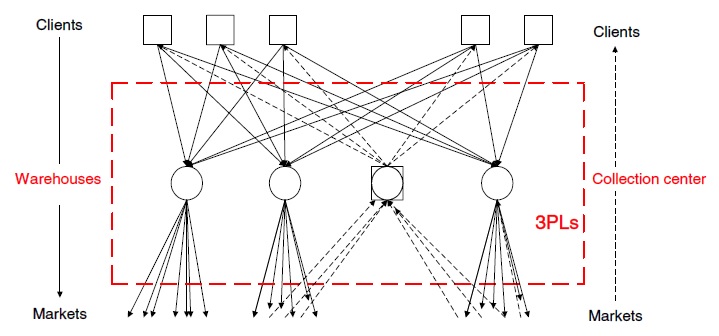
Figure 1: An Integrated Logistics Networks Structure (Ko and Evans, 2007)
We have thus analyzed the evolution of the logistics structure, which being described as a Supply Chain, is now considered as a Supply Network. This concept of logistic networks is an essential concept in our research as our objective is to study them as a new type of network, based on the Internet, called the Physical Internet, for a better use of resources.
2. State of the Art in the Physical Internet
2.1. Introduction
The digital internet represents the best example of collaborative and expandable network since it started in the late 20th century. Although being exclusively virtual, it can be an excellent model to follow for logistics networks that struggle to conciliate cost efficiency, swiftness, and CO2 emissions’ reduction. The physical internet, based on said model, still needs to be adjusted through various analogies to fit the requirements of the physical world.
The Physical Internet is then the set of methods and protocols followed to allow the movement, the storage, the supply and use of physical objects with greater efficiency and sustainability.
We first encounter the term “Physical Internet” on the front page of The Economist, as it was released in June 2006. Back then, the article was only criticizing the limits of modern supply chains and the dangers lurking them while somehow recognizing the level of advancements the field is getting. However, it was far from imagining the complex model PI has been getting through the recent years.
In this chapter, we study the different analogies, found in the literature, made between the digital internet and the physical one as well as their divergent and convergent points.
2.2. Basic lexical analogies
To better understand the physical internet, its main components are transposed from the digital internet following the general aspects of a network, knowingly the flow, the node and the arc, as well as the whole architecture.
2.2.1. The flow
In a packet switched-network like the digital internet, datagrams are used as basic transfer units. Sent data is encapsulated in their payload sections and headers are added to identify them and allow their flow within the network.
These internet packets may differ with the application and user’s needs. TCP packets are used for a reliable and error-checked communication between hosts, and UDP packets are used as simpler, connectionless communication between them.
Similarly, the π-Containers, exclusive to the physical internet, allow the encapsulation of merchandise and its de-capsulation following the routing information obtained for each one of them. However, size in the physical world is an issue as the π-Containers’ content can’t be decomposed, so the final π-Container gets bigger for it has modular smaller π-Containers put together to guarantee a better flow.
2.2.2. The node
As a router is an intermediate node in a computer network providing packet routing between separate networks, a hub in the physical internet allows the π-Containers to be briefly stocked for sorting and forwarding to the next transport.
When we look at the final nodes of the physical internet, we find the supplier or the consumer who provides a place of containerization and de-containerization. The host in the virtual internet provides similar traits by either encapsulating packets and sending them through the network, or receiving them for the opposite process.
The most important nodes in the digital internet are the AS or Autonomous systems which are a set of routers owned by a certain entity that can be a company like an Internet Service Provider or an organization.
We notice two models of π-hubs as nodes in the physical internet. The Multimodal π-hubs connects two different types of transportation, like the PI Road-Rail π-Hub that unloads trains to load their content to trucks and vice-versa. The Unimodal crossdocking π-hubs allow the π-containers routing on the same type of transportation, like the Road-Based crossdocking π-hub in where arriving trucks are unloaded and then dispatched trucks get loaded with the appropriate π-containers in their turn.
2.2.3. The arc
The digital internet relies on wired and wireless connections to form its network, and while it is very heterogeneous, this does not affect the datagrams that flow within it.
The most important arc of the digital internet is a set of multimode fiber optic cables connecting countries and continents spread all over the world buried inland and crawling under seas and oceans.
Regular or punctual transport between two nodes whether it is terrestrial, maritime or aerial, is what constitutes the arc in the physical internet. However, in this case, the destination is not the only factor of routing decision, but also the nature of the π-Container as size, weight and content matter in the choice of the transport type thus the arc.
Transportation in this model, vehicles including trains, truck and ships, is considered part of the arc as it establishes the link between the nodes (π-Hubs) for the flow (π-containers) to get through.
2.2.4. The architecture
The digital internet has a similar topology at every level of its networks. A higher collection of these networks is become an Autonomous System (AS) and falls under the administration of a single entity or organization, mostly Internet Service Providers (ISPs).
Physical Autonomous Systems also exist and are abode to specific rules set by the company or organization managing this logistic network, ranging from express carriers to international third-party logistics providers (3PLs).
While administrative authorities don’t theoretically exist for the digital internet, they are represented by zones of sovereignty in the physical internet. This adds a new barrier, like countries’ borders, that was inexistent in the virtual internet.
Table 1: Simple analogies between digital and physical networks
| Network | Internet | Physical Internet | Interconnection function |
| Flow | Datagram | PI-Container | Encapsulation of merchandise |
| Node | Router | Hub | Location of orientation (sorting), change of mode, service provider |
| Host (unique adress) | Supplier or consumer | Location of containerization and de-containerization | |
| Arc | Wire or wave connection | Transport services | Punctual or regular transport between two nodes |
2.2.5. The routing
The Proposed routing protocol in the Physical Internet mostly relies on the Dijkstra algorithm used to find the shortest path between each node, including parameters like the lead time spent in transportation, routing centers and waiting, logistics cost that covers transport, container handling and sorting, and CO2 emissions from the transportation itself, etc. It tries to solve three main problems: filling containers, routing the flows and grouping containers for departure.
To achieve the best routing configuration, containers should be grouped after arrival, as they arrive asynchronously.
However, time to sort them is always required and they must be sorted following this set of rules:
• Priority of departure
• PI-Container properties: weight, size, etc.
The PI-Containers are modular, so they can be grouped together to form a bigger PI-Container, maximizing the filling-rate. The filling-rate optimization is seen as multi-knapsack problem and solved with an adapted greedy algorithm [6].
The Physical Internet initiative tend to consider the PI-Hubs, where the PI-Containers’ transitions occur, as part of the same entity, or the same network, following the same set of rules [6]. However, in the real world, Logistic Service Providers have different set of rules followed in their hubs.
2.3. A layered approach
The layering concept offers various assets to the physical internet that justifies this choice:
- Complex tasks are split into smaller ones within this framework
- Components are easily changed while interfaces remain intact
- Interoperability is maintained as the upper layers can always use services from the lower layers if the interface is the same.
The physical internet, by mimicking the digital internet’s model, sets itself to follow the Open Systems Interconnection model (OSI). It is known that the digital internet falls under a simplified OSI model, called the TCP/IP model but the OSI model offers a richer and more rigorous presentation through its seven layers.
This leads to the Open Logistics Interconnection (OLI) Model of the Physical Internet. To grasp the idea behind the OLI model, first, we get to define the OSI model and its different layers.
2.4. The OSI Model
This model describes the concepts and the approach to standardize the Open Systems Interconnection. Also we define a network as consisting of open systems if the change, addition or deletion of one of these systems does not change the overall behavior of the network).
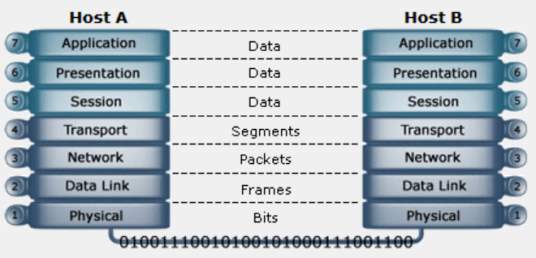
Figure 2: Open Systems Interconnect Reference Model, ISO7498, Organization for International Standardization (ISO).
- The Physical Layer: The physical layer is responsible for transmission of bits over a communication channel. This layer must guarantee the complete data transmission.
- The Data Link Layer: It has a binding role: it will transform the physical layer into an error-free transmission to the network layer. It stacks the incoming data into frames, transmits these frames in sequence and manages the acknowledgment frames returned by the receiver.
- The Network Layer: This is the layer that manages the subnet, i.e. routing packets on that subnet and the interconnection of different subnets between them.
- The Transport Layer: This layer is responsible for the delivery of complete messages to the recipient. The primary role of the transport layer is to take the messages of the session layer, cut if necessary into smaller units and pass them to the network layer, while ensuring that the pieces arrive correctly to the other side. Likewise, this layer also performs the reassembly of the received message to the upper level.
- The Session Layer: This layer organizes and synchronizes exchanges between remote tasks. It sets up the link between logical addresses and physical addresses on the assigned tasks.
- The Presentation Layer: This layer processes information so as to make it compatible between communicating tasks. It will ensure the independence between the user and the information transport.
- The Application Layer: This layer is the contact point between the user and the network. It brings to the user the services offered by the network.
2.5. The OLI Model
Like the OSI model, the Open Logistics Interconnection Model adopts seven layers as it is still in its early stages of development.
These sevens layers are names: (1) physical, (2) link, (3) network, (4) routing, (5) shipping, (6) encapsulation, and (7) Logistics Web.
- The Physical Layer: The π-containers, the means of transport they’re shipped on like vehicles and conveyors, and the hubs where they’re stored and sorted are the main elements of the OLI’s model. The π-container’s structural and electrical specifications are also achieved within this layer.
- The Link Layer: Errors and unexpected events are constantly corrected within this layer and hand-overs of π-containers between operators are performed in possible accordance to standards like EPCIS[1].
- The Network Layer: Interconnectivity, integrity and interoperability of networks within the Physical Internet are ensured within this layer. The π-containers are also composed and decomposed at this level, controlling their flow within the network.
- The Routing Layer: The definition, the engagement and the control of the π-routing protocols are determined in the routing layer. The π-means with each network are monitored to have their service capability, capacity and performance assessed.
- The Shipping Layer: Shipping recipients are set, managed and closed at this level of the OLI model. The shipments themselves get also verified, adjourned or terminated following protocols and rules set at this layer.
- The Encapsulation Layer: Products are efficiently encapsulated in π-containers that are uniquely identified before flowing within the network. All the π-services in contact by the users are monitored at this level and taken to the upper level.
- The Logistics Web Layer: The users of logistics services can exploit the physical internet through the interface implemented in this layer. Software for supply chain management, operations management and enterprise resource management are also set and found at this level of the physical internet.
In the following figure, we illustrate the scenario of a client-supplier purchase order with a focus on inter-layer services.
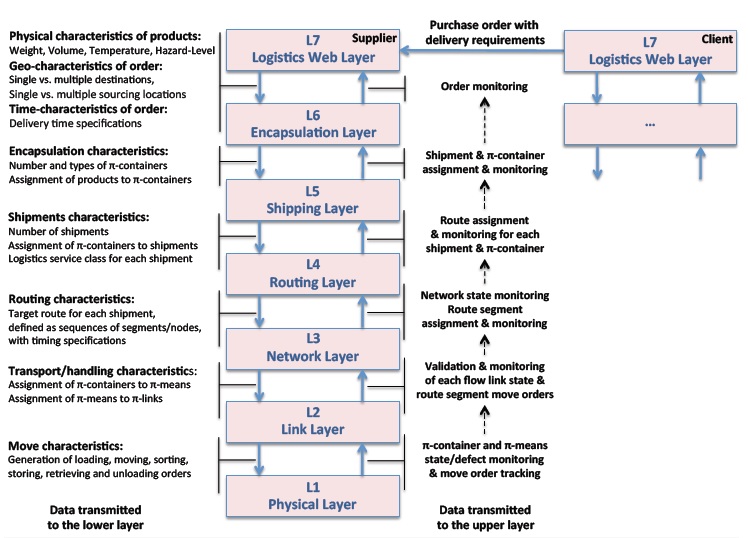
Figure 3: Inter-layer service description within the OLI Model
Adding to the OSI Model, each actor at each layer insures specific actions, similarly logical and physical within a lateral structure. For example, at the lowest layer, a truck is loaded with a π-container physically and then logically as a confirmation of the performed physical loading is insured.
2.6. Conclusion:
In the previous literature, we notice that the physical internet, while being in its early stages, has to thoroughly follow the digital internet’s example and the OSI model even with considerable differences between the two networks.
However, with more in-depth research, we might notice a further detachment from the OSI model as some layers would be merged and others detailed. This happened with the digital internet and the appearance of the TCP/IP model where the OSI’s session, presentation and application layers were merged into the TCP/IP’s application layer to fulfill the distinctive requirements of this global network.
3. Physical Internet Analogies: BGP and PI-BGP
3.1. Introduction
Protocols like the BGP proved to be valuable in interconnecting heterogeneous Autonomous Systems in the Internet. We use, in this paper, similar mechanisms for interconnecting autonomous systems and routing the PI-Containers in the Physical Internet.
In fact, instead of focusing only on routing vehicles or imposing routing protocols on every Logistic Service Provider (LSP) participating to the Physical Internet, each LSP can evolve into a Physical Internet Autonomous System (PI-AS), using their own routing protocols, but following a set of standards, including the proper handling of PI-Containers and a proper communication and cooperation way with other PI-AS. To encourage LSPs to be part of the evolving Physical Internet, not every set of logistic rules should be standardized as some of them should be simply considered as best practices. This would provide some lenience that would be welcomed by potential PI-AS.
Existing research provides a routing protocol for the Physical Internet which is based on shortest path algorithms and is optimized using the Vehicle Routing Problem (VRP) [3]. The Vehicle Routing Problem (VRP) is used to design an optimal route for a fleet of vehicles to serve a set of customers, given a set of constraints. The VRP is used in supply chain management in optimizing the physical delivery of goods and services.
In [4], the existing routing protocol uses different variants of the VRP:
• Vehicle Routing Problems with Backhaul: transportation of goods from number of depots or central locations to a set of line haul customers
• Pick-up and Delivery Vehicle Routing Problem: goods are picked up at customer’s location and directly delivered to other customers
These two variants follow respectively the Client-Server model and the Peer-to-Peer (P2P) model found in the Internet. However, the routing, being focused on the vehicle instead of the packet itself, doesn’t take full advantage of these models which are using the BGP criteria.
We conceive that the vehicles used for transportation need to be addressed simply as a link with various states, instead of a flow, to achieve a better transposability from the digital Internet to the Physical Internet. The dynamic routing should then consider the PI-Containers as the sole flow of the Physical Internet.
3.2. BGP in the Internet
BGP is a routing protocol between autonomous systems in the Internet, currently in its 4th version. It is known to be robust and scalable [7]. The primary function of such system is to exchange network reachability information with other BGP systems.
The BGP-4 is an interesting routing protocol to adapt for the Physical Internet because it introduces mechanisms allowing the aggregation of routes [8].
Communication between AS is a key factor for the BGP to function properly. BGP neighbors must exchange full routing information in order for routes to be established between them. This happens the first time and updates only involve changed routes between BGP neighbors [7].
BGP works simply by routing packets to the neighbors (routers) with the highest Weight, figure 3.
To easily find BGP neighbors, IP addresses are allocated using the Classless inter-domain routing (CIDR) Address strategy, allowing the discovery using the addresses’ prefixes.
CIDR allows topologically allocate IP address assignment, by allocating segments of the IP address space to the transit routing domains [9]. It is used to create unique identifiers for networks and individual devices.
In the physical worlds, topological addressing can be solved with GPS coordinates of different PI-Hubs. A standardized naming system can also be used to simplify the use of long GPS coordinates in the Physical Internet.
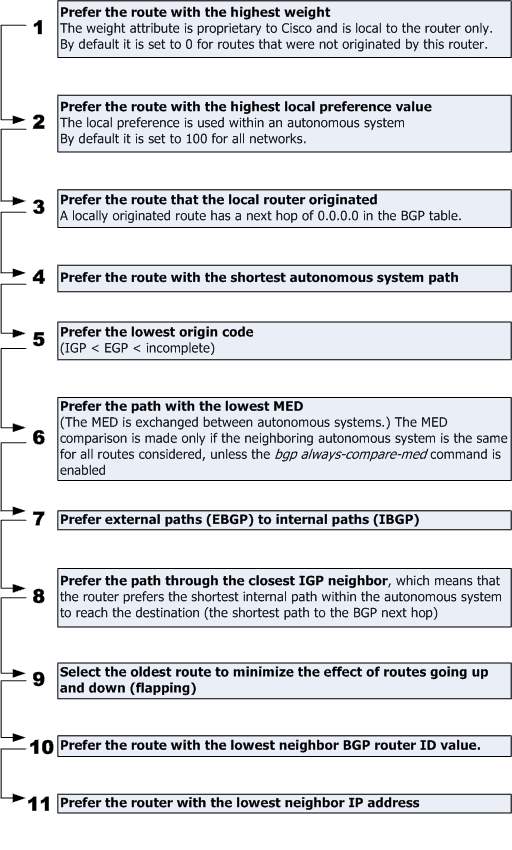
Figure 4: BGP Routing State Chart
3.3. PI-BGP
3.3.1. Standards
Logisticians have always viewed standards as solutions for improving operational compatibility and coordination, as it leads to “lock-in” as a trade-off between adaptation and adaptability, previous standards must be taken into account to ensure continuity between classic logistics and the Physical Internet [10].
Between two destinations, the PI-BGP routing should find a consensus between the number of PI-Hubs stops, the duration of transportation and wait as well as the different costs.
The PI-Hubs are considered as nodes of the Physical Internet and can be part of a same PI-AS or different ones if the routes are concatenated between them, similarly to the BGP-4 in the digital Internet.
The standards in the PI-BGP should consider these points:
PI-Containers dimensions: all PI-AS should use standardized sizes for the PI-Containers to allow a smooth transition between two different means of transportation from two different PI-AS.
Switching from Cross docks to PI-Hubs: Cross docks are widely spread among LSPs to transfer containers between two different means of transportation but are getting outdated and can barely handle the large flow of merchandise going through them causing unacceptable delays. A transition to PI-Hubs would mean a faster flow and shorter delays as PI-Containers are quickly unloaded, sorted with PI-Sorters, transferred with PI-Conveyors then loaded again to the outgoing vessel. With PI-Hubs, loading and unloading times are reduced by 90% thanks to the use of PI-docks instead of forklifts and resource usage is reduced by 87% [11]. Respective overviews are shown in figure 4.
Communication between PI-BGP neighbors: updates should be more frequent, in contradiction with the BGP. These communications should include:
Forwarding PI-AS: PI-Containers nature, dimensions and weight
Receiving PI-AS: availability for PI-containers, different costs for available positions, time estimate.
Different roads and PI-Hubs conditions.
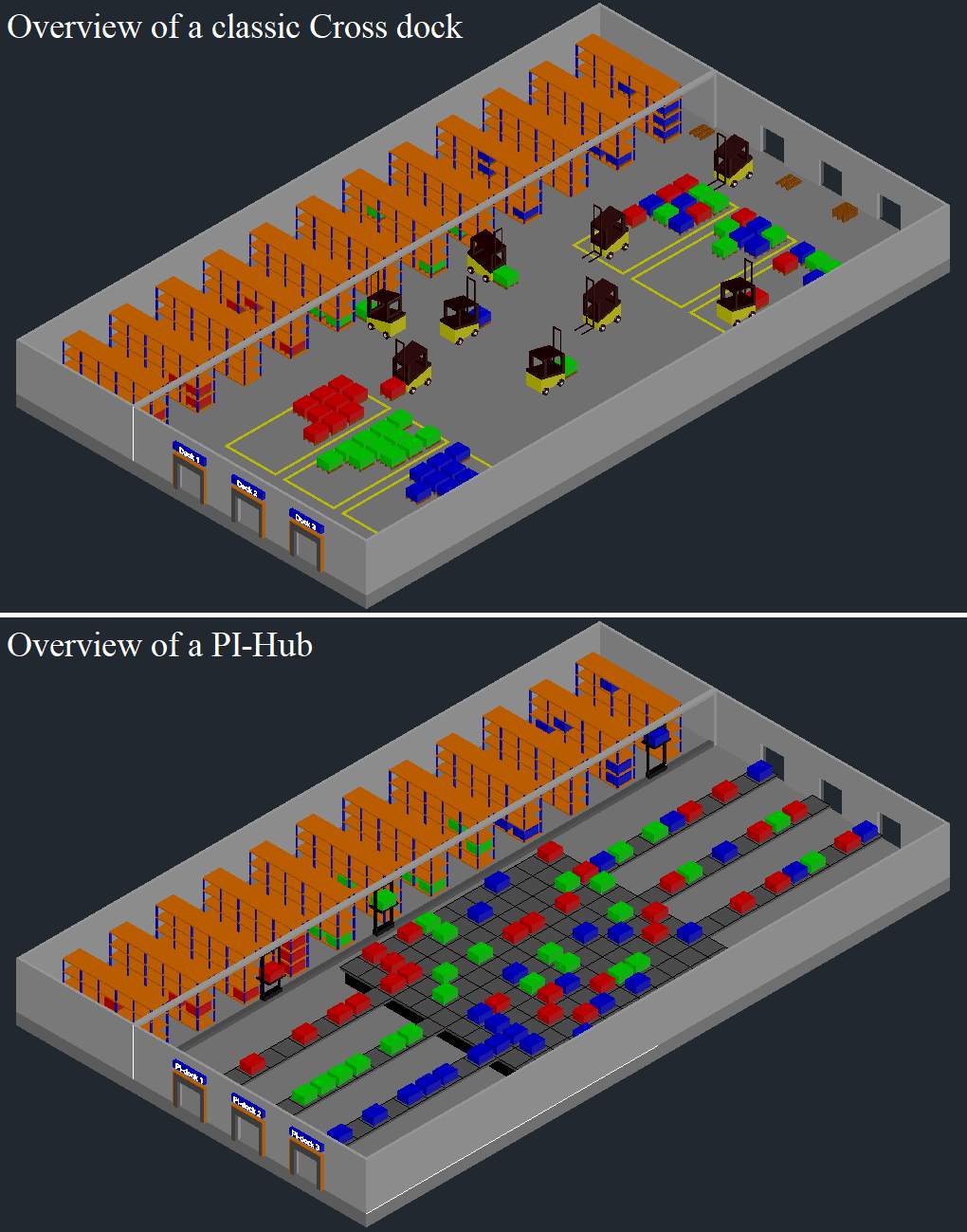
Figure 5: Overviews of a class cross dock and a PI-Hub
3.3.2. Best Practices
PI-AS, or Logistic service providers participating in the Physical Internet should have a fixed schedule of their different transportations and fixed negotiated routes.
A more detailed communication about the nature of the PI-Containers and their requisites should facilitate a further designation of following PI-BGP neighbors.
The best practices are merely recommendations to LSPs acting as PI-AS in the Physical Internet; a more detailed communication is negotiated as part of the agreements between them.
3.3.3. The Selection of LSPs
Logistic service providers’ management is the outsourcing of logistics operations to a third party. Companies, or clients, use these third parties known as logistics service providers (LSPs) to provide logistics services. LSPs may provide logistic services to one or more clients at any given time. Clients may choose to outsource a portion, or all of their logistics services to one or more LSPs [12].
The Physical Internet would be most likely made of a group of LSPs linked together and cooperating with each other, like the Autonomous Systems in the Digital Internet, thus the appellation of PI-AS for the LSPs as they are chosen to be part of this initiative.
We can choose the convenient LSPs to be part of the Physical Internet by applying the standards and best practices previously addressed to an Analytical Network Process (ANP) that would allow determining the most adequate LSPs already using or willing to use standards close to the ones in our approach [13].
3.3.4. Analogies between BGP and PI-BGP
The BGP and PI-BGP would show strong analogies as they operate similarly in Table II.
Table 2: Analogy between BGP and PI-BGP
| Elements | BGP | PI-BGP |
| Autonomous Systems | Internet Service Provider (ISP) | Logistic service provider (LSP) |
| Physical Components | Router | PI-Hub |
| Routing Technique | Sending packets to a neighboring router | Checking the closest available PI-Hub to send the PI-Container to, with the soonest-departing truck |
| Addressing | CIDR | GPS Coordinates and/or Physical Addresses |
| Route Attribute | Each path gets attributed a Weight. The path with the highest weight is preferred. | The route attributes would consider several factors: weather, traffic, availability of the next PI-Hub… |
We can also perceive schematically this analogy on large network mappings of router and logistics maps as shown in Figure 6.
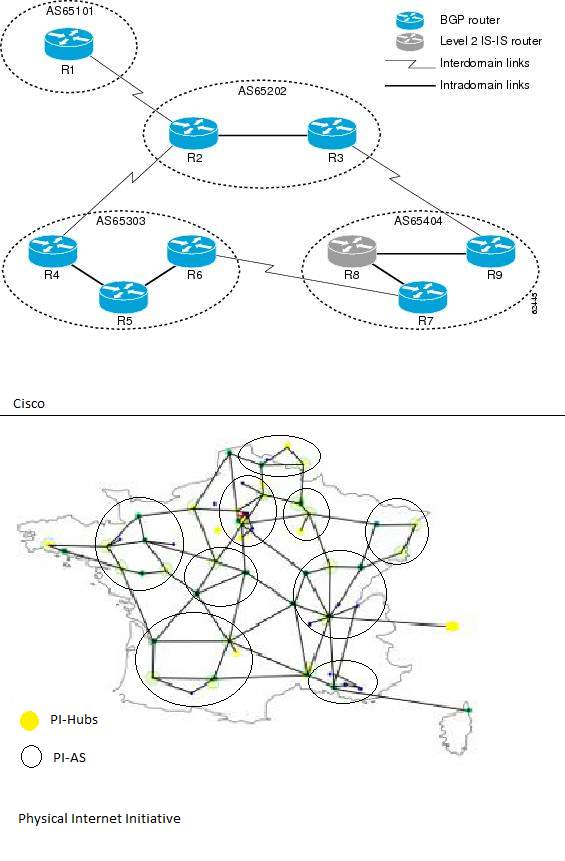
Figure 6: Graphic Analogy between BGP and PI-BGP
3.3.5. The PI-BGP Algorithm
The PI-BGP algorithm is based on the BGP best path algorithm as it would have previously determine a valid path and consider it as the best path and then follow a set of rules to determine the next PI-AS and/or PI-Hub.
The proposed algorithm is given as a set of rules to follow to determine the best path:
- The starting PI-Hub determines the next PI-Hubs in the route that form the shortest path for a chosen PI-Container. The PI-Container is then loaded in the first available truck to the next designated PI-Hub.
- While on its way to the next PI-Hub, information about the PI-Containers is sent to the latter.
- The next PI-Hub also receives information from oncoming trucks and their next destinations, as well as traffic information.
- An estimate for each PI-Container is produced, including waiting and loading time with each truck going to the following PI-Hub on the route.
- If no trucks are available, or inacceptable delay is predicted, the PI-Hub chooses another PI-BGP neighbor to which the PI-Container would be re-routed, within the same PI-AS.
- Step 2 is repeated for each new PI-Hub reached until the PI-Container reaches its final destination.
The main advantage of the PI-BGP is its capacity to allow the change of the next PI-Hub if a certain delay is to be found, or the route and/or truck following it is unavailable.
So by re-routing to neighboring PI-Hubs, we can avoid delays and congestion of the PI-Hubs with PI-Containers waiting for their predetermined route to be available again for them.
3.3.6. Case Study
3.3.6.1. The Network Profile
The Physical Internet in France, for instance, would count several PI-Hubs spread all over the country, having numerous LSPs dissevering them. Some of these LSPs are local, like Gefco and Bansard, and others are international, like DHL and FedEx. These PI-Hubs might be exclusive to one LSP or shared between several of them, if agreed upon.
Between two neighboring PI-Hubs, several trucks are traveling, following different pre-established routes, set by their own LSPs.
3.3.6.2. The Routing Process
A PI-Container would depart from a starting location on a truck heading to a neighboring PI-Hub A located on the shortest path established by default, shown as the red thick line in figure 6. A congestion would happen on this route, between PI-Hub A and B, as the PI-Container is on its way.
Information about this predictable delay after the departure to PI-Hub B on the established path is sent to PI-Hub A. Thanks to other information about departures to other neighboring PI-Hubs, a new route for this PI-Container is then established, based on the re-routing times being lower than the congestion delay. After a quick unloading, sorting and loading with the PI-Sorters and the PI-Conveyors and following the new route, the PI-Container departs from PI-Hub A to the new neighboring PI-Hub A1, on a different truck, instead of a departure straight to PI-Hub B, limiting delays on the road and avoiding a stocking process.
Following the new route, the PI-Container arrives to PI-Hub A1 and departs to again on a decongested route to PI-Hub B, where it resumes its flow on the default path established at the beginning as no further congestions or similar delays exist in this scenario.
In a classic vehicle routing approach, the departure from PI-Hub A to PI-Hub B is inevitable and the path is unique. This means that the vehicle would have faced the congestion causing inacceptable delays for the Physical Internet.
Thanks to the PI-BGP, we avoided the congested path between PI-Hub A and B by rerouting the PI-Container to PI-Hub A1, limiting significantly any delay and skipping any stocking process in the PI-Hubs.
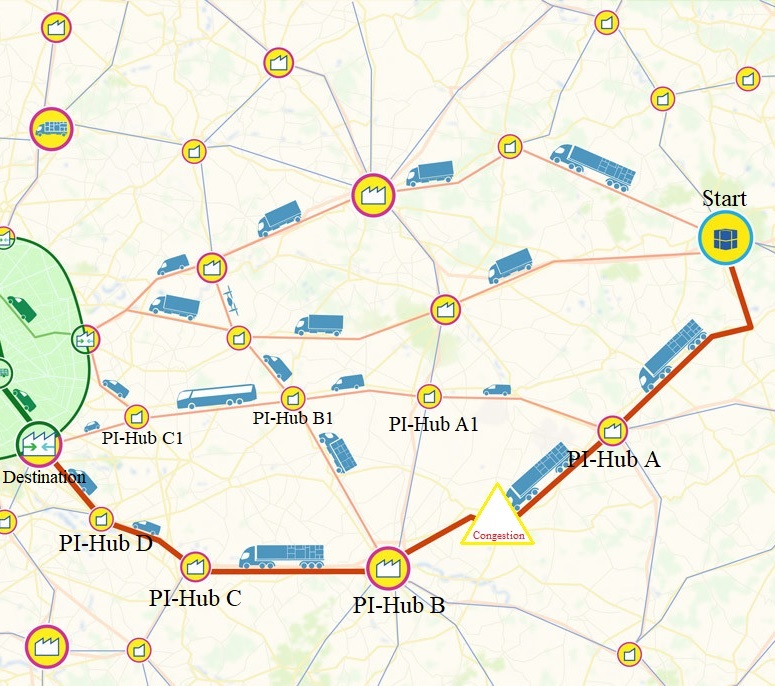
3.3.7. Simulation
Two versions of the simulation have been established:
- A small scale simulation, focused on one city, scattering several Pi-Hubs acting as hops for the Pi-Containers, with more dynamism in the routing process.
- A large scale simulation, established on a whole country, in this scenario, France, with PI-Hubs scattered over the major cities, acting as Source Pi-Hubs, Transit Pi-Hubs and Destination Pi-Hubs, with fewer hops per Pi-Container, due to computer limitations.
3.3.7.1. AnyLogic Presentation
AnyLogic is a tool that offers multiple perspectives in simulating scenarios about any kind of logistics. It offers in-depth setting options, with the creation of abstract and concrete agents capable of handling tasks of any nature.
AnyLogic is a simulation tool developed by The AnyLogic Company. It has a graphical modeling language and also facilitates the extension of the simulation model with Java code. The PLE edition is the one used for our simulations, as it is free of charge, it has limited features but it is enough to handle the various tasks at hand.
3.3.7.2. Small Scale Simulation
In this scenario, the small scale simulation has a starting Pi-Hub from where all the PI-Containers depart to a Destination PI-Hub, however, depending on the traffic and average speed prediction, a Pi-Hub is chosen as a transit, or a “next Hop” as named in the PI-BGP protocol.
As traffic data is lacking, the average speed prediction is decided through a uniform discrete distribution to allow the fair use of all the routes presented in the simulation.
The Discrete Uniform distribution is a discrete distribution bounded on a minimum and a maximum with constant probability at every value on or between the bounds. Sometimes called the discrete rectangular distribution, it arises when an event can have a finite and equally probable number of outcomes.
Following the PI-BGP protocol, as it is a small scale simulation, the possible scenarios are easily numbered, and they are the following:
- Starting PI-Hub → PI-Hub A → PI-Hub B → Destination PI-Hub
- Starting PI-Hub → PI-Hub A1→ PI-Hub B1 → Destination PI-Hub
- Starting PI-Hub → PI-Hub A → PI-Hub B1 → Destination PI-Hub
- Starting PI-Hub → PI-Hub A1 → PI-Hub B → Destination PI-Hub
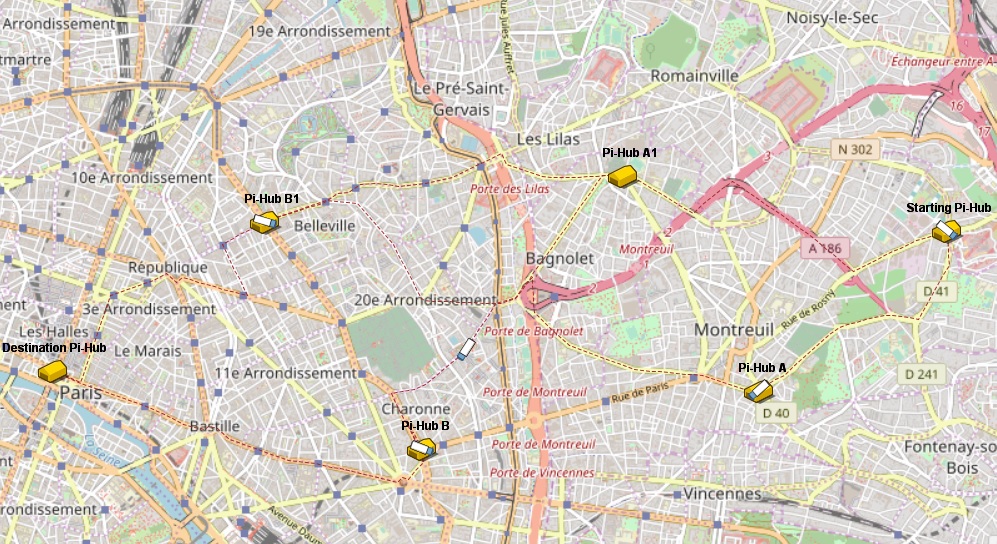
Figure 8: Small Scale Simulation Map
3.4. Perspectives of the PI-BGP
The PI-BGP relies on the information exchange between PI-AS to always find the best path and, as in the BGP, it doesn’t always mean the shortest. Information exchange is crucial for this step to succeed, so a centralized system receiving all these information would allow a better and faster use for it. An autonomous distributed information system for logistics control has been proposed to manage the flow of the items efficiently and dynamically [14], but it has yet to be implemented as a centralized system to achieve interoperability between LSPs acting as PI-AS in the Physical Internet.
For Cross-Docking PI-Hubs, the information is heterogeneous as the means of transportations differ, as well as the requisites for the PI-Containers. An algorithm to transpose the data for each mean of transportation would solve this issue. In the digital Internet, a similar problem is solved by changing the Maximum Transmission Unit (MTU) depending on the connection type [15]. However, in the Physical Internet, even if the PI-Containers are modular, size variation is still problematic and needs to be addressed.
The selection of the LSPs, following an analytical network process, or a potential permission to be part of the Physical Internet initiative need to be addressed in details, as these companies must follow the standards of Physical Internet, especially the PI-Containers regulations and the routing mechanisms.
3.5. Conclusion
The PI-BGP should be about mutual trust, communication and cooperation between every Logistic Service Provider participating to the Physical Internet following the successful steps of the BGP in the digital Internet.
Standards and best practices should show more lenience towards Logistic Service Providers that want to be part of the Physical Internet but do not want to cooperate if unmanageable changes are imposed instead.
Focusing on the exclusive routing of PI-Containers following the PI-BGP, we can guarantee a quick flow within and between PI-Hubs, reducing delays and solving stocking problems.
Bibliography
There are no sources in the current document.
Table of Figures
Figure 1: An Integrated Logistics Networks Structure (Ko and Evans, 2007)
Figure 3: Inter-layer service description within the OLI Model
Figure 4: BGP Routing State Chart
Figure 5: Overviews of a class cross dock and a PI-Hub
Figure 6: Graphic Analogy between BGP and PI-BGP
Figure 8: Small Scale Simulation Map
Table of Tables
Table 1: Simple analogies between digital and physical networks
[1] EPCIS is a GS1 standard that enables trading partners to share information about the physical movement and status of products as they travel throughout the supply chain, from business to business and ultimately to consumers.
Cite This Work
To export a reference to this article please select a referencing stye below:
Related Services
View allRelated Content
All TagsContent relating to: "Computing"
Computing is a term that describes the use of computers to process information. Key aspects of Computing are hardware, software, and processing through algorithms.
Related Articles
DMCA / Removal Request
If you are the original writer of this dissertation and no longer wish to have your work published on the UKDiss.com website then please:




